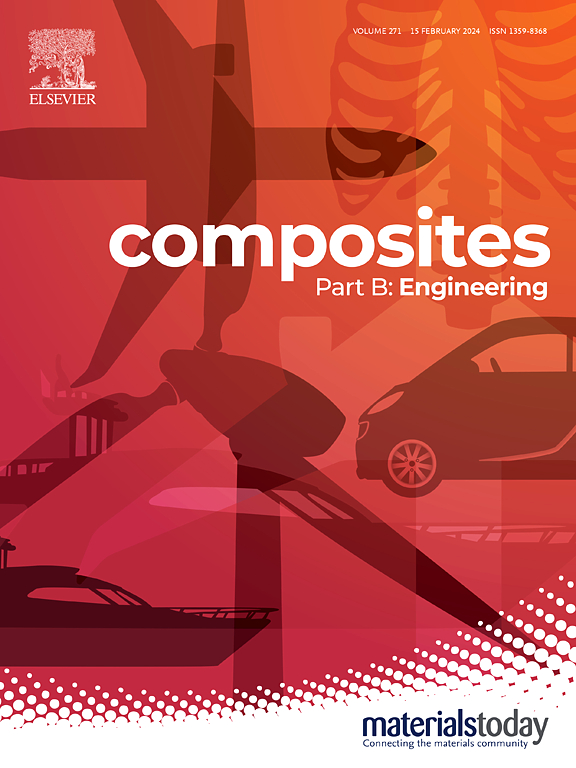径向柱塞式液压马达用scf增强PEEK/PTFE复合材料的摩擦学性能和注塑成型
IF 12.7
1区 材料科学
Q1 ENGINEERING, MULTIDISCIPLINARY
引用次数: 0
摘要
聚醚醚酮(PEEK)基复合材料以其高强度和耐磨性而闻名,是解决高负载条件下摩擦和磨损问题的有前途的材料,特别是在径向柱塞液压马达的摩擦副中。本研究采用双螺杆挤压和注射成型技术制备短碳纤维(SCF)增强PEEK/聚四氟乙烯(PTFE)复合材料试样。在不同的SCF填充率下,通过环盘测试来评估摩擦性能。结果表明,SCF显著降低了复合材料的摩擦系数(CoF)和磨损率(Wr)。然而,矩阵修复SCF的能力是有限的。当SCF填充比为15 wt%时,该复合材料的平均CoF为0.023,Wr为0.331 × 10−8 cm3 N−1 m−1,显示出优异的摩擦学性能。微观分析表明,磨损主要通过轻微的犁削和粘着磨损发生。在低速、高负荷工况下,对含有15wt % scf改性PEEK/PTFE的三层轴承衬套进行了测试,显示出出色的润滑和承载能力,适用于高负荷应用。本文章由计算机程序翻译,如有差异,请以英文原文为准。

Tribological properties and injection molding of SCF-reinforced PEEK/PTFE composites for radial piston hydraulic motors
Polyetheretherketone (PEEK)-based composites, renowned for their high strength and wear resistance, are promising materials for addressing friction and wear issues in high-load conditions, particularly in the friction pairs of radial piston hydraulic motors. In this study, short carbon fiber (SCF)-reinforced PEEK/polytetrafluoroethylene (PTFE) composite specimens were prepared using twin-screw extrusion and injection molding techniques. The tribological properties were assessed via ring-on-disc testing at varying SCF filling ratios. The results show that SCF significantly reduces both the friction coefficient (CoF) and wear rate (Wr) of the composites. However, the matrix's ability to fix the SCF is limited. At a 15 wt% SCF filling ratio, the composite achieves the lowest average CoF of 0.023 and Wr of 0.331 × 10−8 cm3 N−1 m−1, indicating excellent tribological performance. Microscopic analysis reveals that wear primarily occurs through slight plowing and adhesive wear. A three-layer bearing bushing containing 15 wt% SCF-modified PEEK/PTFE was tested under low-speed, high-load operating conditions, demonstrating excellent lubrication and load-bearing capabilities, making it suitable for high-load applications.
求助全文
通过发布文献求助,成功后即可免费获取论文全文。
去求助
来源期刊

Composites Part B: Engineering
工程技术-材料科学:复合
CiteScore
24.40
自引率
11.50%
发文量
784
审稿时长
21 days
期刊介绍:
Composites Part B: Engineering is a journal that publishes impactful research of high quality on composite materials. This research is supported by fundamental mechanics and materials science and engineering approaches. The targeted research can cover a wide range of length scales, ranging from nano to micro and meso, and even to the full product and structure level. The journal specifically focuses on engineering applications that involve high performance composites. These applications can range from low volume and high cost to high volume and low cost composite development.
The main goal of the journal is to provide a platform for the prompt publication of original and high quality research. The emphasis is on design, development, modeling, validation, and manufacturing of engineering details and concepts. The journal welcomes both basic research papers and proposals for review articles. Authors are encouraged to address challenges across various application areas. These areas include, but are not limited to, aerospace, automotive, and other surface transportation. The journal also covers energy-related applications, with a focus on renewable energy. Other application areas include infrastructure, off-shore and maritime projects, health care technology, and recreational products.
 求助内容:
求助内容: 应助结果提醒方式:
应助结果提醒方式:


